Disclamer: This article was created as part of the ReisebloggerWG in cooperation with the city marketing Brunswick.
Brunswick is still considered an insider tip in Northern Germany. The second-largest city in Lower Saxony is beautiful and has many rewarding sights.
I like the North of Germany. As a child, I spent three vacations with my parents and grandparents on the East Frisian island of Langeeog in the North Sea. I have also been to the Baltic Sea twice. Therefore, I was happy when I got the opportunity to spend two days in Brunswick a while ago. As a result, I got to know another city in Northern Germany after Hamburg, Lübeck, and Wolfenbüttel. Before I explored Brunswick by myself, I attended a very interesting and entertaining tour with the city guide Rainer Feuge and five of my fellow travel bloggers.
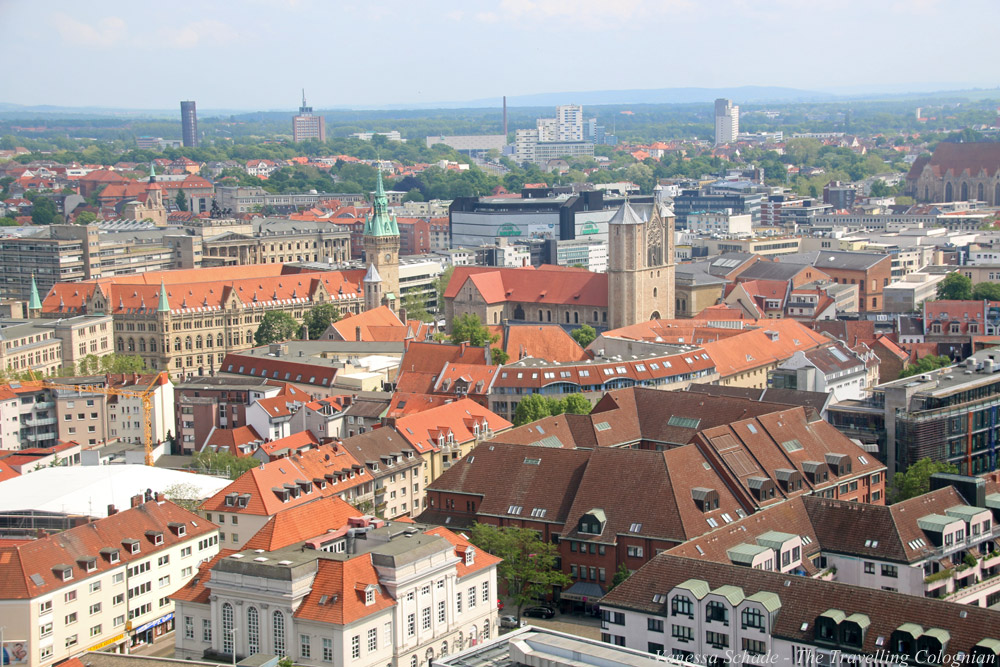 Brunswick city center with the Brunswick Cathedral and Town Hall from the South Tower of St. Andrew’s Church
Brunswick city center with the Brunswick Cathedral and Town Hall from the South Tower of St. Andrew’s Church
Castle Square (Burgplatz)
The castle square (Burgplatz) with its medieval layout is probably the heart of the city. Around the square, the Brunswick Cathedral St. Blasii, Dankwarderode Castle, the former Viewegsche publishing house and present-day Brunswick State Museum, the Huneborstel House and the von Veltheim’s House, both in half-timbered style, are grouped. In the centre of the square, in front of the Dankwarderode Castle, the Brunswick Lion sits enthroned. On the left, in front of the cathedral, there is a miniature of historic Brunswick. A specifically arranged selfie point not only offers selfie hunters but also photographers a good location to photograph the buildings of the castle square.
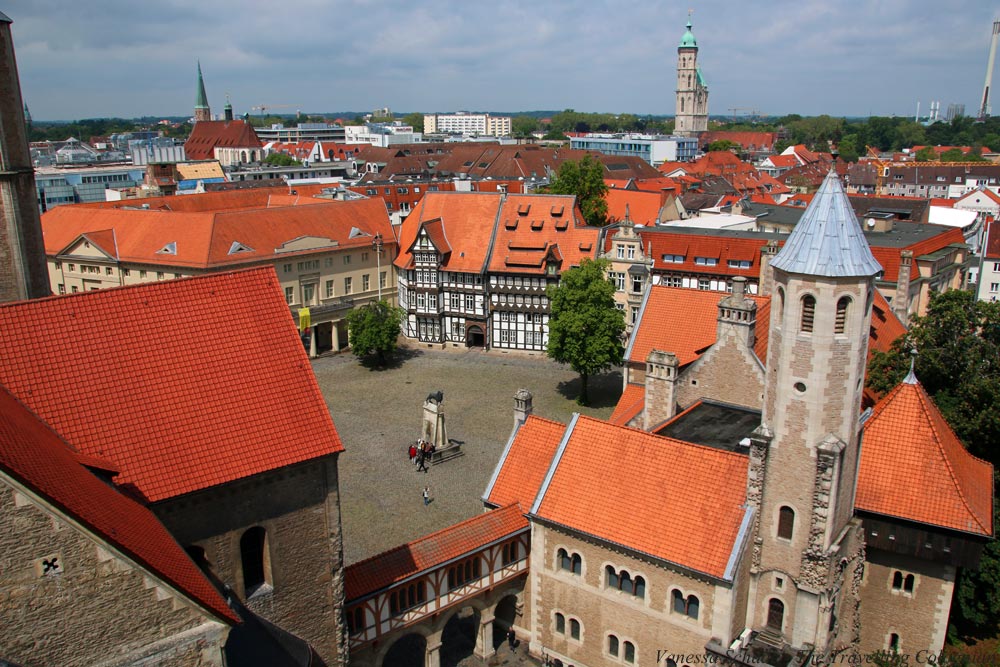 Castle Square from above (seen from the Town Hall Tower)
Castle Square from above (seen from the Town Hall Tower)
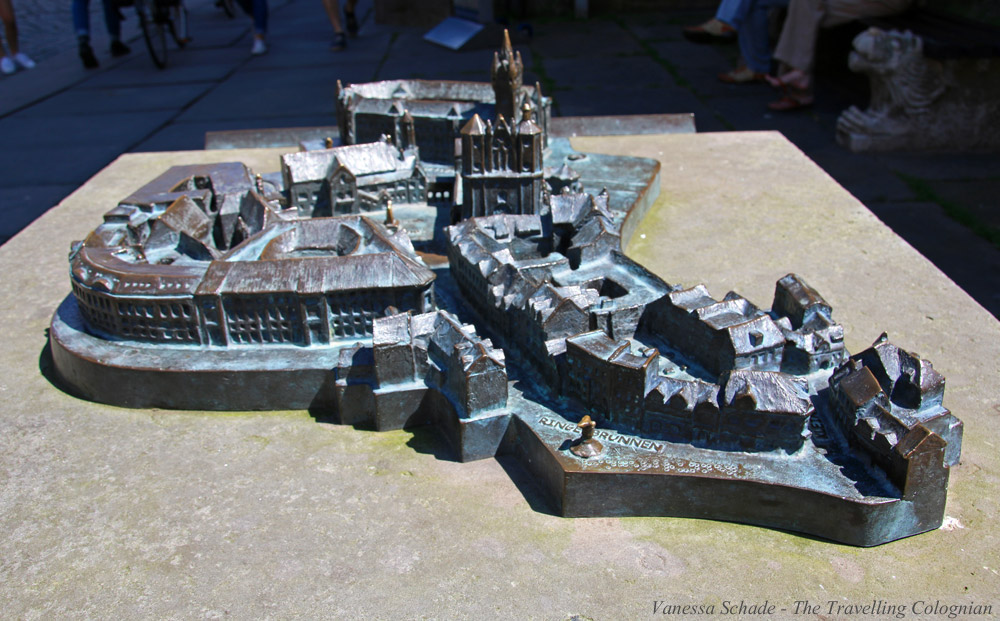 Miniature of historic Brunswick
Miniature of historic Brunswick
Brunswick Lion (Braunschweiger Löwe)
The Brunswick Lion (Braunschweiger Löwe) stands in the centre of the castle square and is the landmark of the Guelph Duke Henry the Lion, who made Brunswick his residence between 1165 and 1195. The original statue – a once gilded bronze cast – originally dates from 1166 and was the first free figure north of the Alps. Today’s sculpture is a replica from the year 1980. The original is now one of the exhibits of the Duke Anton Ulrich Museum, but today stands in the Dankwarderode castle.
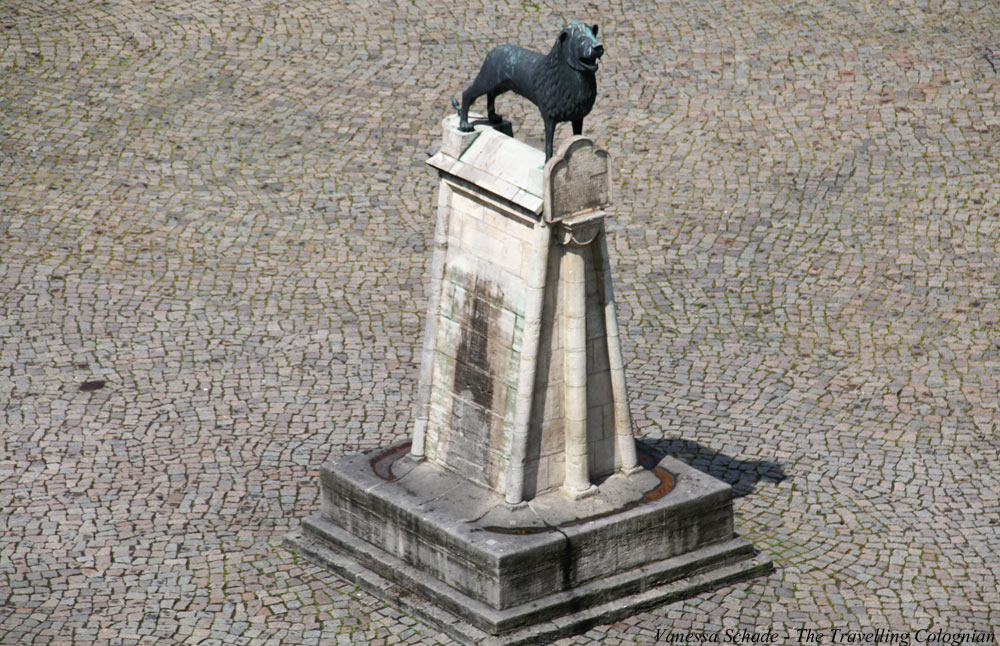 Brunswick Lion from above
Brunswick Lion from above
Dankwarderode Castle
The imposing Dankwarderode Castle towers directly behind the Brunswick Lion. The building is also a replica and was completely rebuilt between 1887 and 1906, after the castle which was originally built as a residence in 1175 by Henry the Lion, burned down. In addition to the original statue of the Brunswick Lion and the medieval department of the Duke Anton Ulrich Museum, it houses parts of the Guelph treasure. Also worth seeing is the Knight’s Hall on the top floor. The castle is open for visitors Tuesday through Sunday from 10 AM to 5 PM.
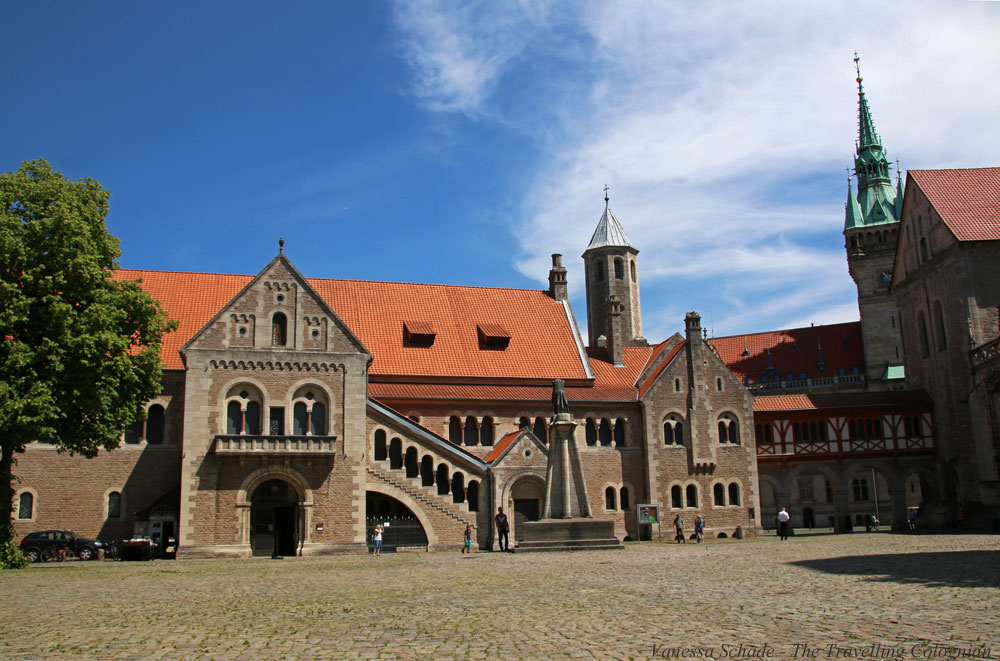 Dankwarderode Castle with the Town Hall Tower (in the background)
Dankwarderode Castle with the Town Hall Tower (in the background)
Brunswick Cathedral St. Blasii (Braunschweiger Dom)
To the right of the Dankwarderode Castle rises the remarkable Brunswick Cathedral – also known as Cathedral of St. Blasii to Brunswick. This is an Evangelical Lutheran cathedral and the most important church in Brunswick. The cathedral was also built between 1173 and 1195 at the instigation of Henry the Lion, but its two towers were never finished. You should visit the cathedral not only from the outside. The seven-armed candelabra, the altar of Mary, the crypt and the Imervard Cross exhibited inside the church are all worth a visit. Brunswick Cathedral is open daily from 10 AM to 5 PM. However, from the beginning of January to the middle of March, the Brunswick Cathedral is closed between 1 and 3 PM.
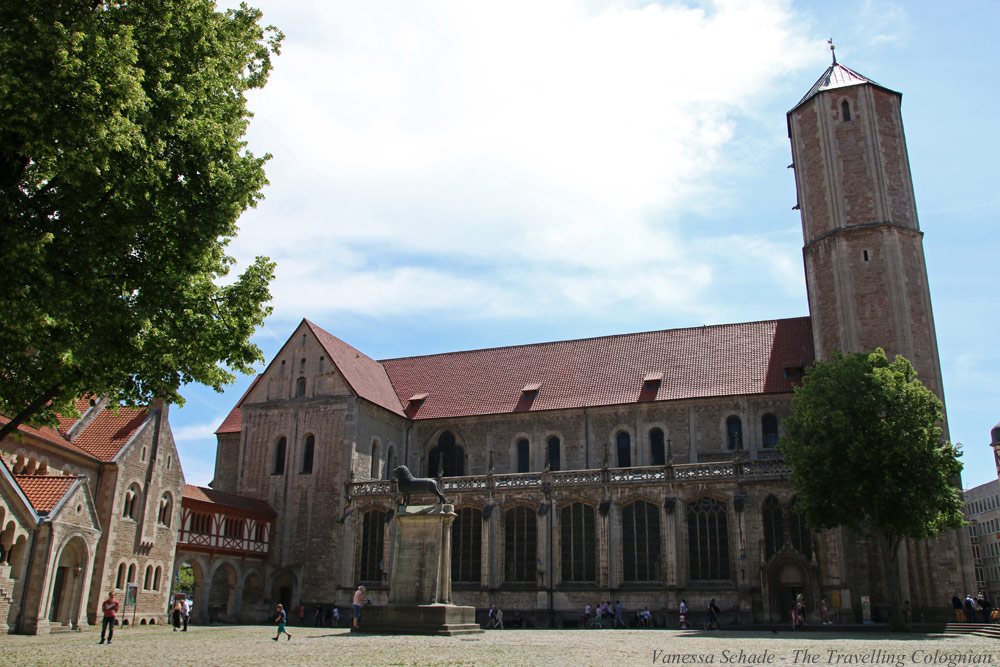 Brunswick Cathedral St. Blasii
Brunswick Cathedral St. Blasii
Von Veltheim’s House and the Huneborstel House
Directly opposite the Brunswick Cathedral are two historic buildings in half-timbered style; the von Veltheim’s House (von Veltheimsches Haus) on the left and the Huneborstel House (Huneborstelsches Haus) on the right.
The half-timbered facade of the Huneborstel house, which today is also known as Gildehaus, dates back to 1525, and the original roof truss was moved from the Sack street in 1901 to its current location. In 1910, an apprentice residence was built in the courtyard of the Huneborstel house using original parts of the houses of Sack street 8 and 9. The von Veltheim’s House is almost 50 years younger than the facade of the Huneborstel house and was built in 1573. Both buildings have been the seat of the Brunswick Chamber of Crafts since 1902.
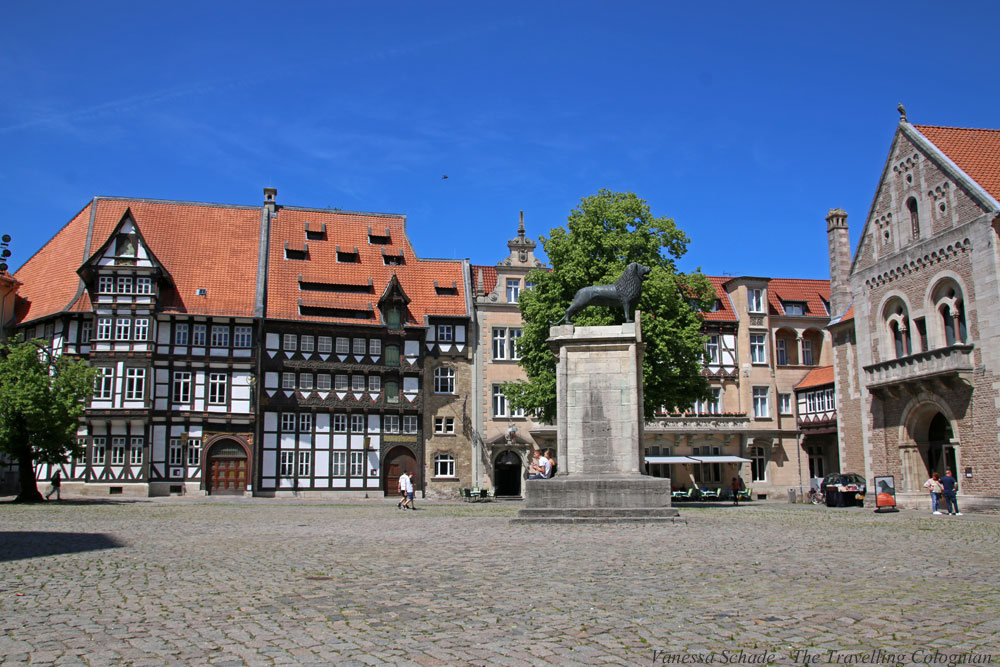 Von Veltheim’s House (left) and Huneborstel House (right)
Von Veltheim’s House (left) and Huneborstel House (right)
Brunswick State Museum in the Vieweghaus
The Vieweghaus is on the left side of the von Veltheim’s house and opposite Dankwarderode Castle and was built between 1799 and 1804. Until 1976, it was a residential and publishing house of Vieweg Fachverlag. Today, the Vieweghaus is one of four locations of the Brunswick State Museum (Braunschweigisches Landesmuseum) in addition to the exhibition center Hinter Ägiden and branch offices in Wolfenbüttel and Bortfeld. In the Vieweghaus, a permanent exhibition documents the development of Brunswick from prehistoric times to the present, as well as regular thematic exhibitions. You can visit them Tuesday through Sunday from 10 AM to 5 PM. Every first Tuesday of the month, the Brunswick State Museum in the Vieweghaus has an extended opening time from 10 AM to 8 PM.
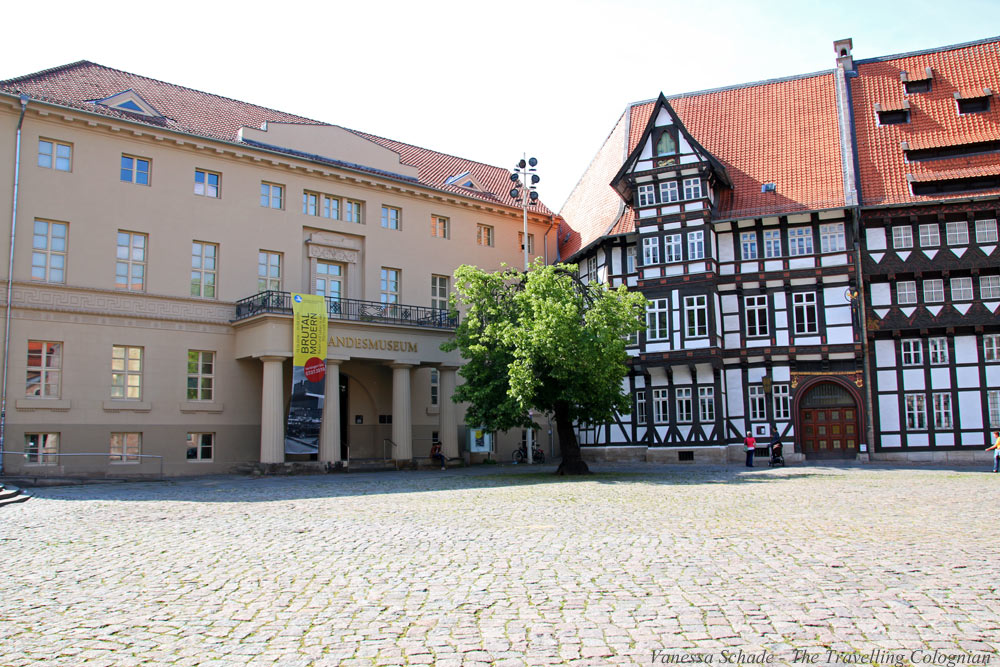 Brunswick State Museum in the Vieweghaus
Brunswick State Museum in the Vieweghaus
Pillar 2000 Years Christianity (Säule 2000 Jahre Christentum)
Behind Dankwarderode Castle on the Ruhfäutchenplatz the Pillar 2000 Years of Christianity (Säule 2000 Jahre Christentum) is located, which was created in 2006 by the sculptor Professor Jürgen Weber. As the name of the pillar implies, it shows the history of Christianity in the past 2,000 years, from the birth and crucifixion of Jesus Christ through the passage to Canossa and Martin Luther’s 95 theses to the terrorist attacks of September 11, 2001.
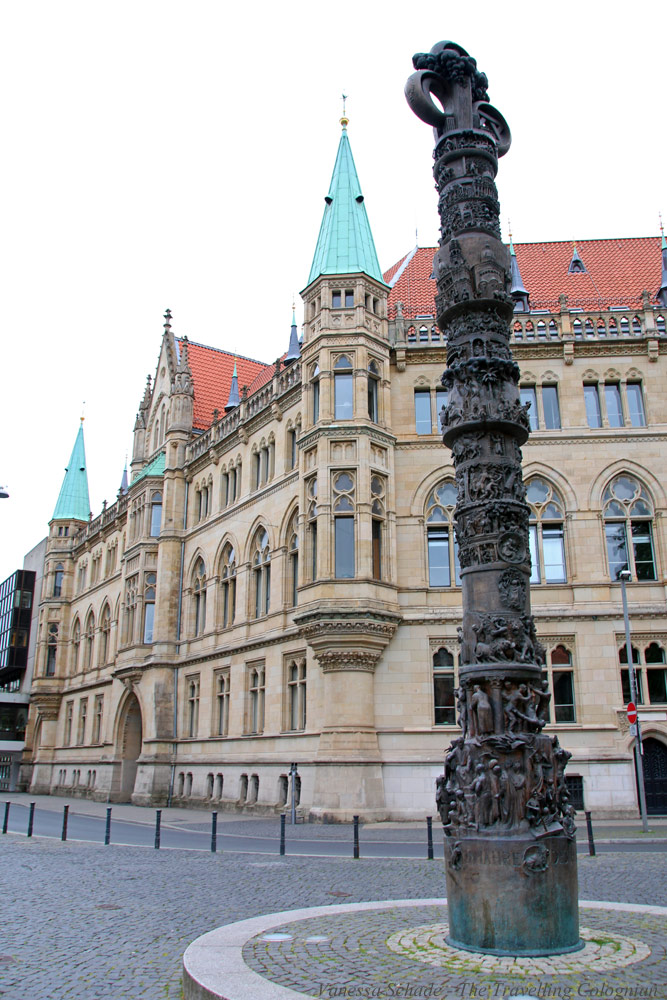 Pillar 2000 Years Christianity
Pillar 2000 Years Christianity
Brunswick Town Hall (Braunschweiger Rathaus)
If you walk from the castle square in a southeastern direction, you will come to the Brunswick Town Hall (Braunschweiger Rathaus), which is located on the square of German Unity. The town hall is a neo-Gothic building and was built between 1894 and 1900. Its windows are decorated with figures representing the areas of commerce, science, art, and craft. The building is the seat of the civil registry office and a memorial for persecuted and murdered Brunswick Sinti. On the square of the German Unity in front of the town hall, a fragment of the Berlin Wall and a commemorative plaque commemorating the German reunification are exhibited.
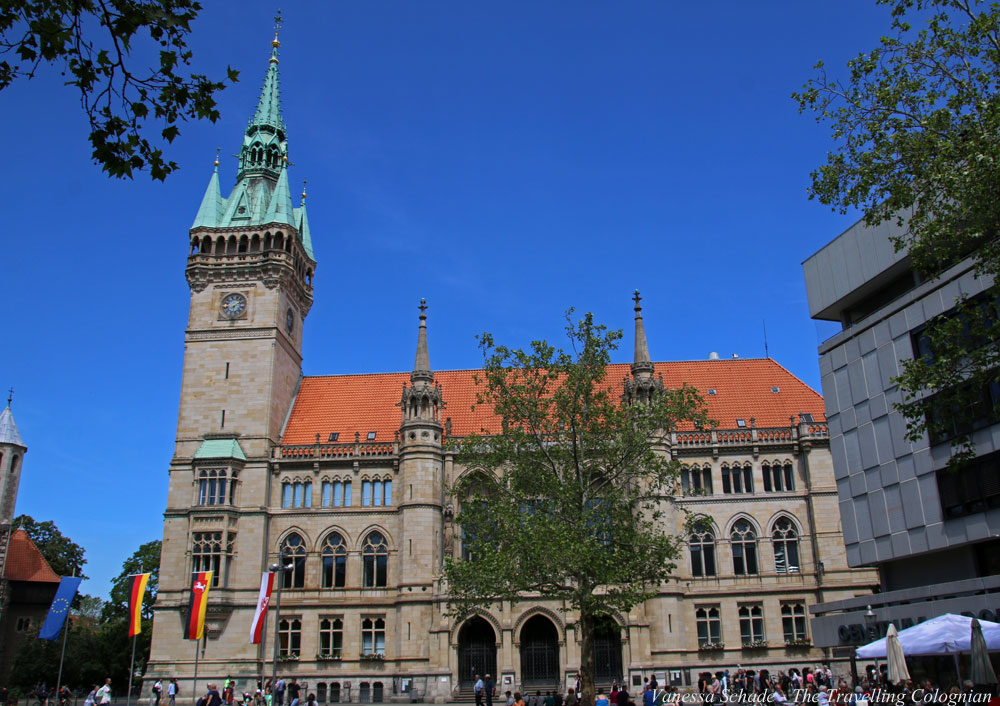 Brunswick Town Hall
Brunswick Town Hall
Brunswick Castle (Braunschweiger Schloss)
Further southeast you will reach the impressive Brunswick Castle (Braunschweiger Schloss), which is also known as the Brunswick Royal Palace (Braunschweiger Residenzschloss). The original building was constructed between 1831 and 1841 by Carl Theodor Ottmer, but it was so badly damaged during the Second World War that it had to be demolished in 1960. The current Royal Palace was built in 2006 on the same site as the original building, with 600 original parts used for the reconstruction. As on the original, a so-called Quadriga, a group of charioteers, also sits enthroned on the replica. The Brunswick Quadriga is the largest group of charioteers in Europe and is led by the city goddess Brunonia. In front of the Brunswick Castle, two equestrian statues of the two dukes Karl Wilhelm Ferdinand (1735 – 1806) and Friedrich Wilhelm (1771 – 1815) are located to the left and the right of the main entrance. While the neighbouring shopping center caused some criticism, the castle itself, with the city archives, the city library, the cultural institute, the cultural administration, and the Red Hall, is an important historical and cultural site.
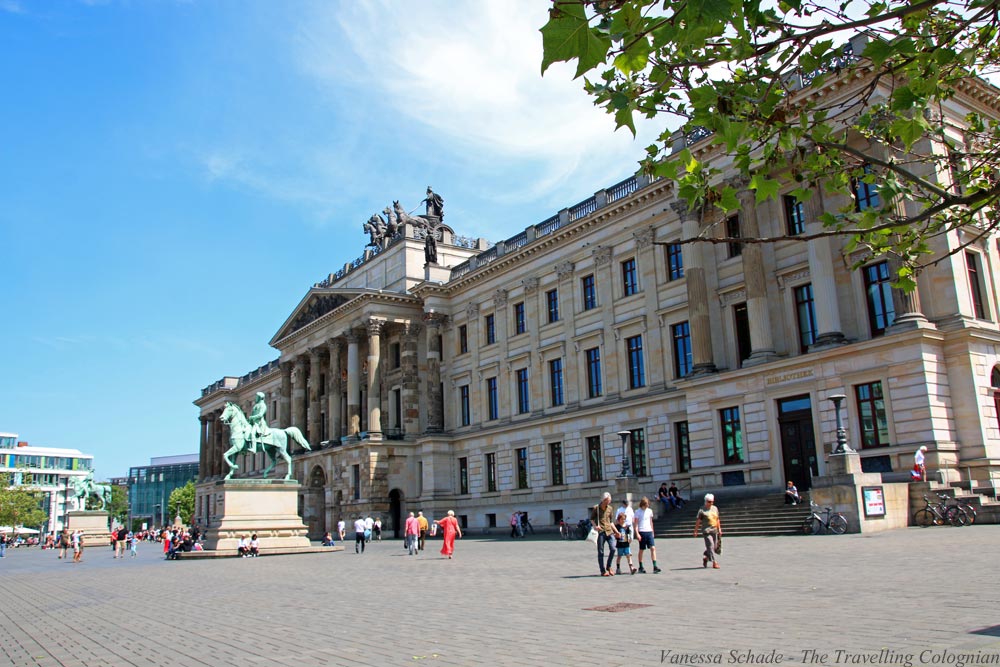 Brunswick Castle
Brunswick Castle
Happy RIZZI House
The colorful Happy RIZZI House with its unusual architecture, pop art paintings, and smiling faces was appealing to me even before my visit to Brunswick and due to its design, the building is sometimes called Villa Kunterbunt. You get there when you walk from Brunswick castle in a southeastern direction. It is located on the edge of the historic Magni quarter and was built in 2001 by New York artist James Rizzi, who had already designed the New Beetle for VW and book covers for Brockhaus. Unfortunately, the Happy RIZZI House is not open to the public, as it houses the headquarters of the New Yorker clothing chain based in Brunswick.
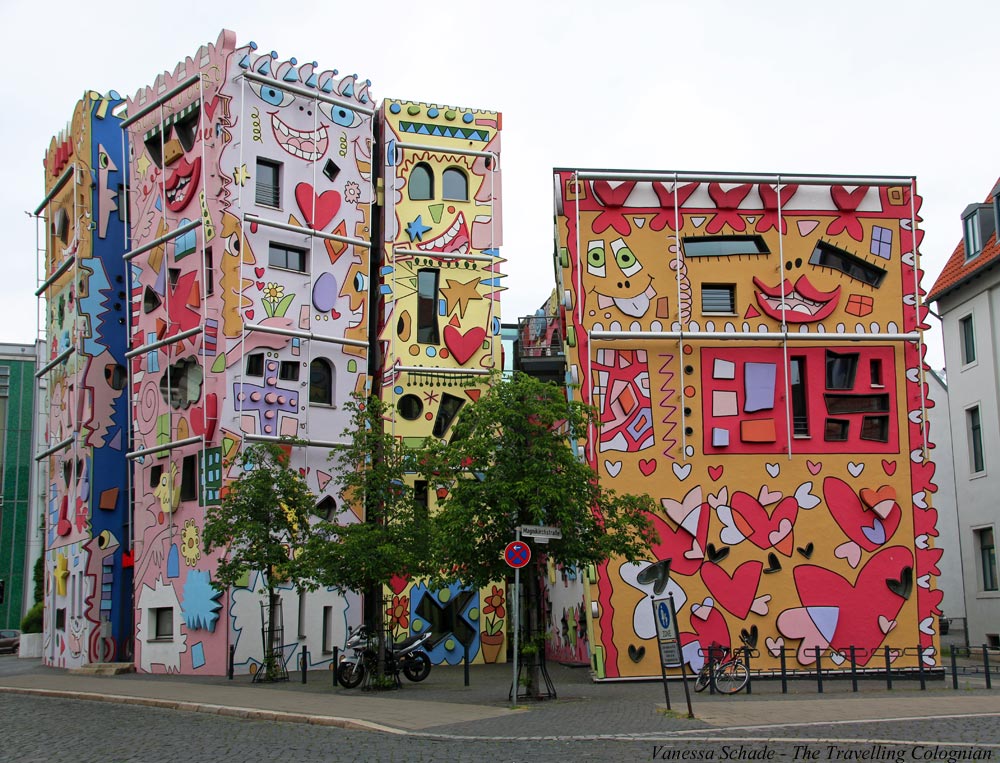 Happy RIZZI House
Happy RIZZI House
Magni Quarter (Magniviertel) with the Church St. Magni
The Magni quarter (Magniviertel) is one of the oldest districts of Brunswick and impresses with its beautiful half-timbered houses, the Magni Church Square (Magnikirchplatz) and St. Magni, the oldest church in the city. It was built from 1252 on the foundations of a former cathedral and is located in the centre of the Magni quarter. After being severely damaged during the Second World War, it was rebuilt between 1956 and 1964, preserving the original choir house and the western building. Inside the church are the sculpture “Der Rufer” by Bodo Kampmann as well as a glass window, which was designed by Gottfried von Stockhausen and shows the movement of the children of Israel through the Red Sea. Both of them are worth seeing. The inside of the Magni church can be visited Mondays to Sundays from 9 AM to 6 PM. Services take place on Sundays at 10 AM. Worthwhile is also a stroll through the street Hinter der Magnikirche behind the Magni church, which leads from Magnikirchstraße to Magnikirchplatz.
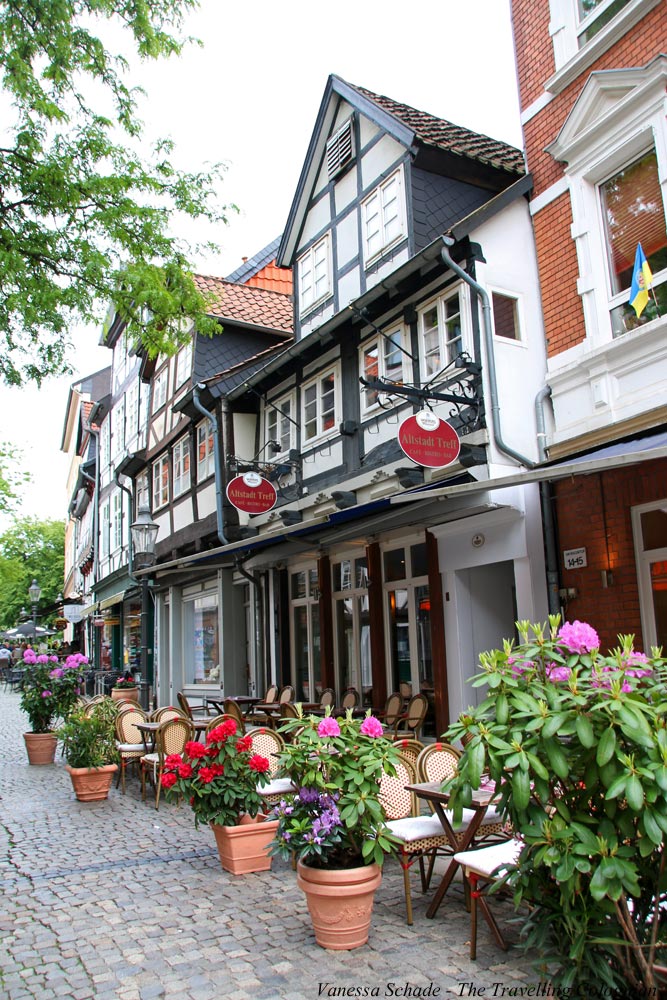 Magni Quarter
Magni Quarter
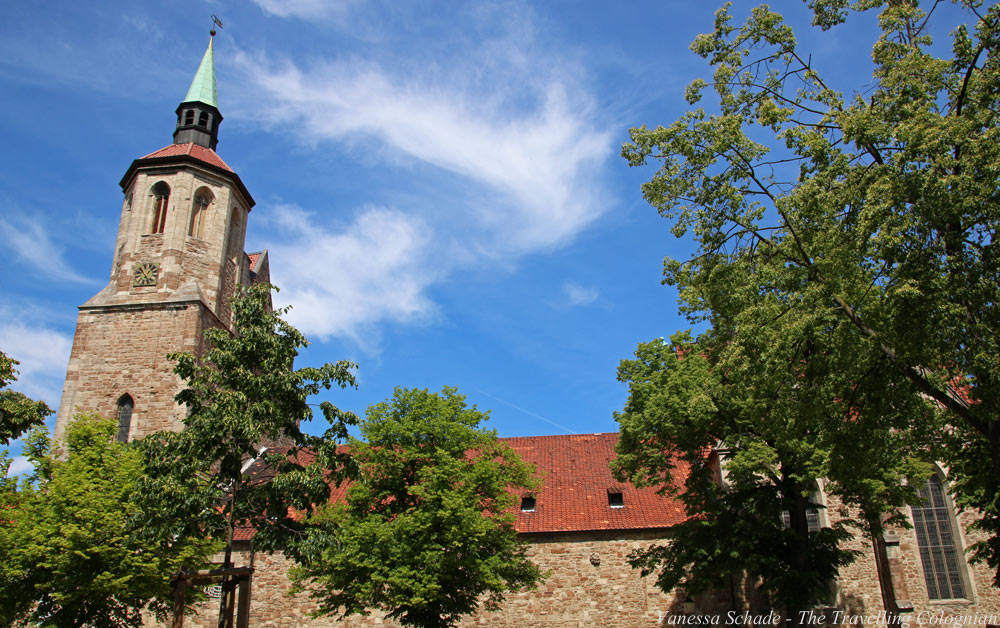 Church St. Magni
Church St. Magni
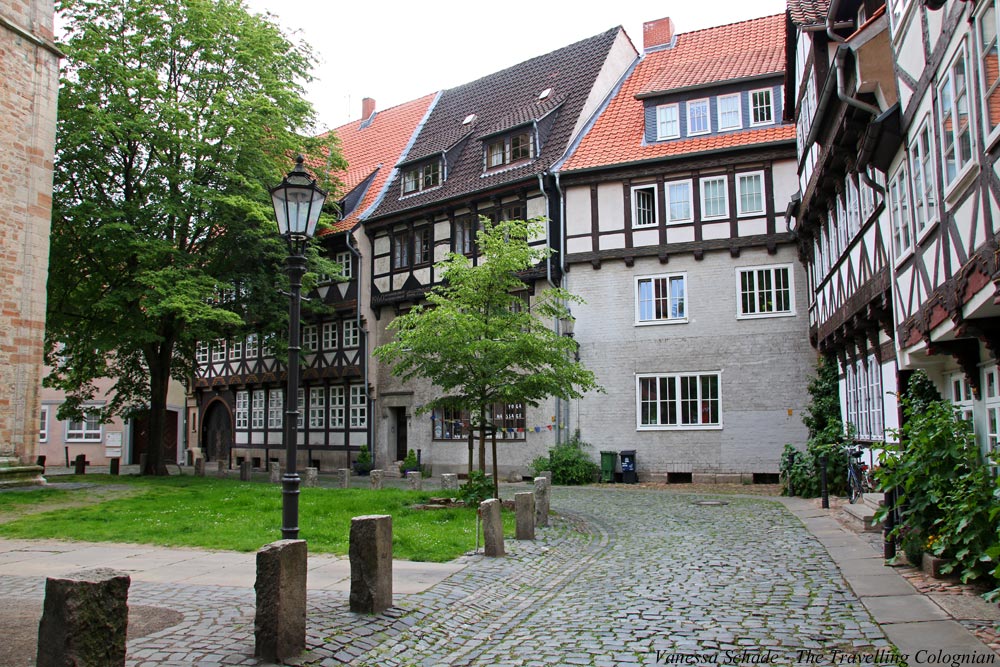 Street “Hinter der Magnikirche”
Street “Hinter der Magnikirche”
Municipal Museum (Städtisches Museum)
Also part of the historic Magni quarter is the Municipal Museum (Städtisches Museum), which is housed in the House on Löwenwall (Haus am Löwenwall). It was built between 1904 and 1906 by the architect Max Osterloh and impresses with its beautiful atrium. The Municipal Museum exhibits various collections of Brunswick’s art and cultural history.
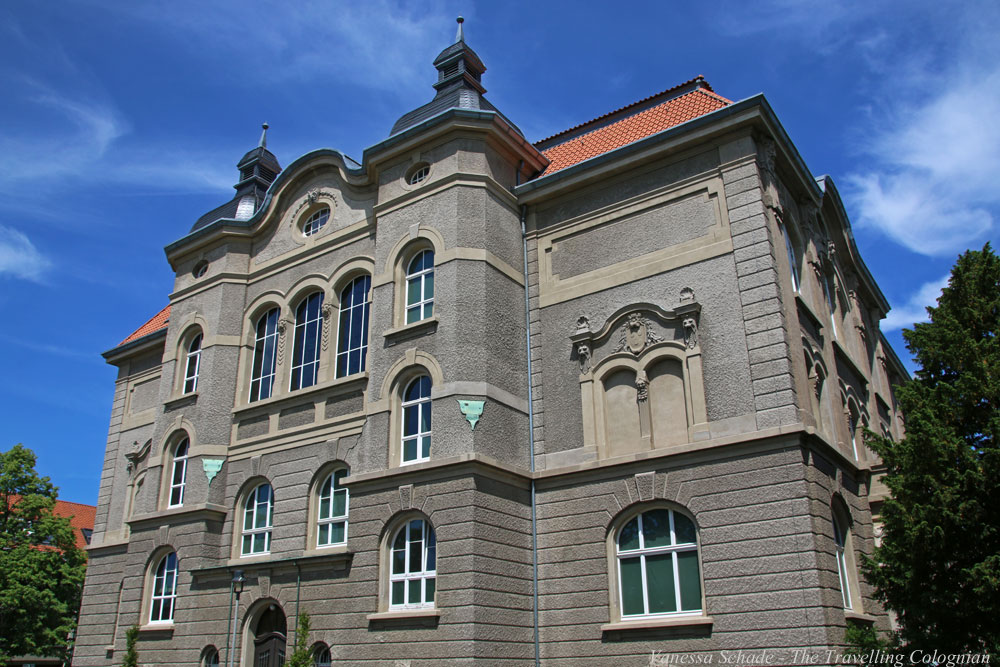 Municipal Museum
Municipal Museum
Lion Wall (Löwenwall) – Obelisk
The Lion Wall (Löwenwall), behind the Municipal Museum, is an oval grass field created in 1820. It is dominated by the 22-metre high obelisk, which is guarded by four bronze lions. The monument was erected in honor of the dukes Karl Wilhelm Ferdinand and Friedrich Wilhelm.
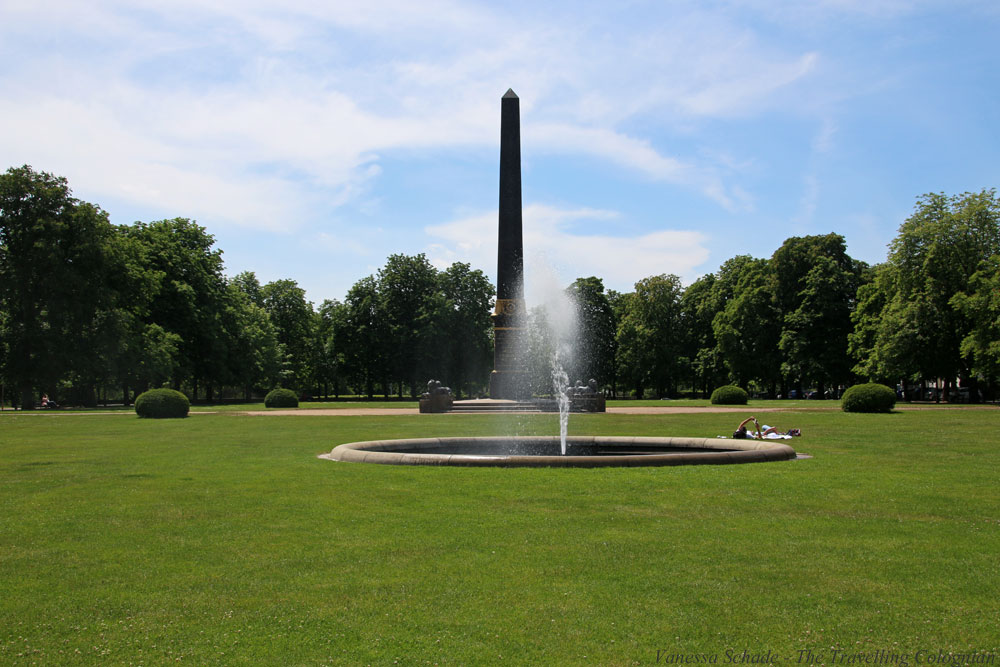 Obelisk on the Lion Wall
Obelisk on the Lion Wall
Coal Market (Kohlmarkt)
The path from the Magni quarter to the pretty Coal Market (Kohlmarkt) leads in a northwestern direction. The coal market is located on the edge of a pedestrian zone in the centre of Brunswick and is characterized by facades of houses from different eras, and a fountain, which was originally built in 1391 and rebuilt in 1869. Also striking are the Till-Eulenspiegel carillon in the attic of the building Kohlmarkt 10 and the house Am Ziegenmarkt 2, which contains a reference to Till Eulenspiegel on a support beam. The coal market was already settled in the 10th century and is now frequently a place of events.
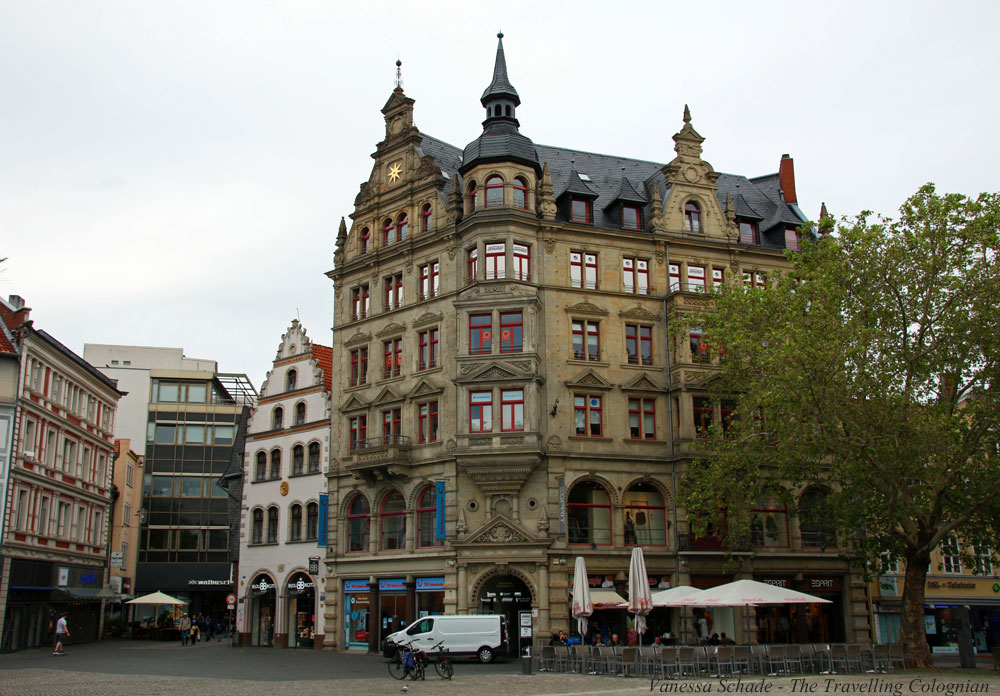 Coal Market
Coal Market
Synagogue
When you head from the coal market in a south-western direction, you will pass the Alte Knochenhauerstraße at the place where a synagogue once stood. It was built in 1875 and destroyed in the Pogrom Night on November 9, 1938. The neighbouring Jewish community centre has been preserved to this day. In 1975, a plaque was donated, which is still reminiscent of the synagogue today.
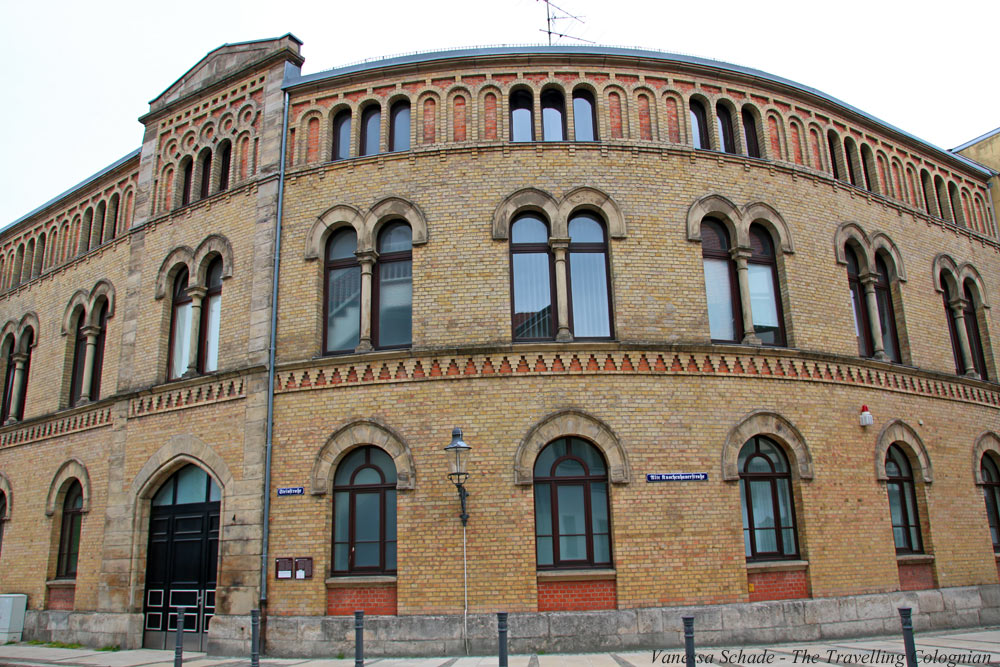 Jewish community centre next to the former Brunswick synagogue
Jewish community centre next to the former Brunswick synagogue
Jacob Bower (Jakob-Kemenate)
A little further to the north lies the Jacob Bower (Jakob-Kemenate), a medieval stone building which today houses a cultural centre. It was built in 1250 and served as protection against fire and raids. It was also used as a representative storage and residential building. In 1765 it became the seat of the first bank in Germany, which was then called the Ducal Leihhausanstalt. During the air raid on Brunswick in 1944, it was so badly damaged that only a ruin remained from the original building. In 2006 it was rebuilt by the architect Rainer Ottinger and the sculptor Jörg Plickat and supplemented by a modern extension.
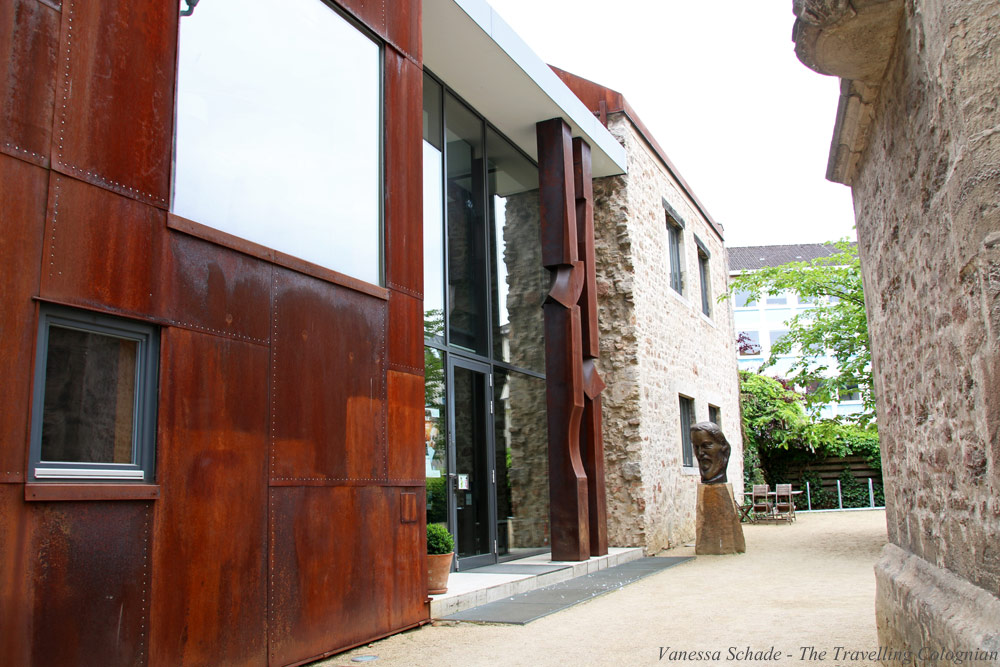 Jacob Bower
Jacob Bower
Old Town Market (Altstadtmarkt)
Just over 200 metres further northeast lies the impressive Old Town Market (Altstadtmarkt) with its beautiful buildings. This has been a place of lively trade for more than 700 years. In the past, the site was used for fairs, as a place of execution and as a venue for processions, equestrian games, and homage. Successively, the St. Martin’s Church (Martinikirche) between the 12th and 14th centuries, the Old Town City Hall (Altstadtrathaus) in the 13th-century, the Gewandhaus with its renaissance gables in 1590-91 and the old customs house (Altes Zollhaus) in 1643 were built here. In the centre of the Old Town Market stands the Marien Fountain (Marienbrunnen), which was cast out of lead in 1408. On Wednesdays and Saturdays, a weekly market takes place on the old town market between 8 AM and 1 PM.
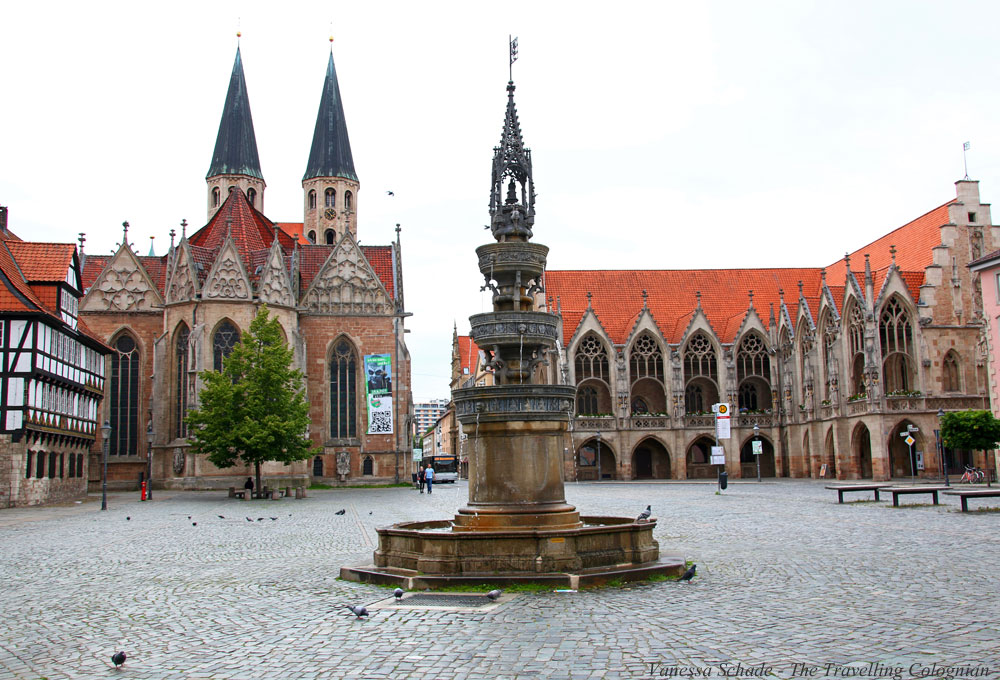 Old Town Market with Marien Fountain, Church of St. Martini, Customs House and Old Town City Hall
Old Town Market with Marien Fountain, Church of St. Martini, Customs House and Old Town City Hall
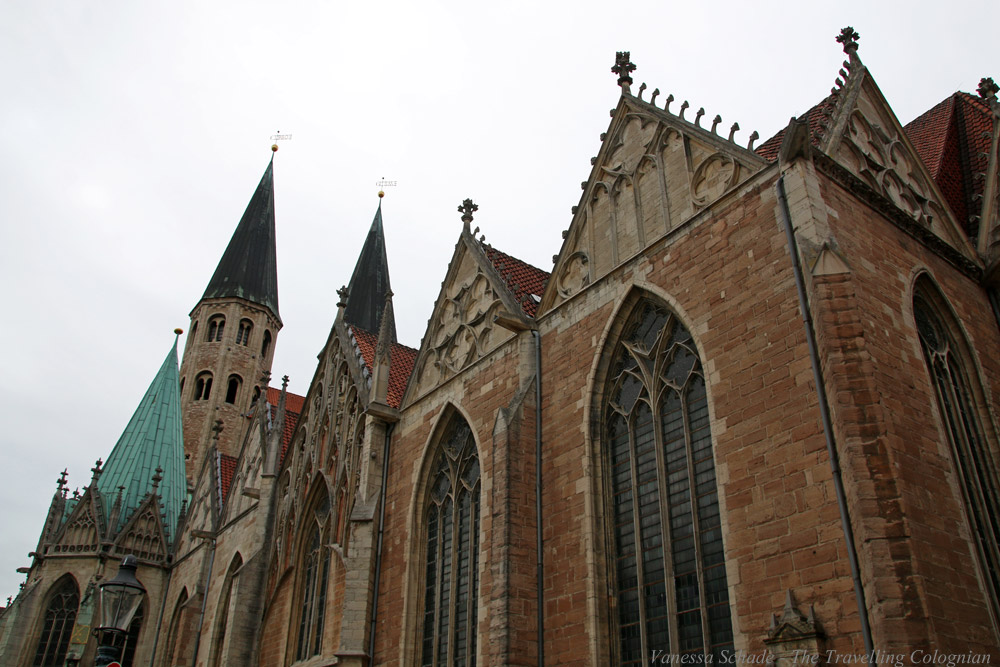 Church St. Martini
Church St. Martini
Old Town City Hall
The picturesque Old Town City Hall is one of Germany’s most important medieval town halls. The Old Town Council used to meet here and it served as a venue for celebrations. The town hall balcony is adorned with nine picturesque pillars depicting emperors, kings, dukes, and their wives. Today, the magnificent building is used for exhibition and representation purposes. On the ground floor and in the basement, a permanent exhibition shows the history of Brunswick from the 9th century to the year 2005. Besides, there are changing special exhibitions. In the so-called Dornse, as the large hall in the main building is called, as well as in the mayor’s room, the city receives its guests. These premises can also be used by private and non-profit organizers for similar purposes.
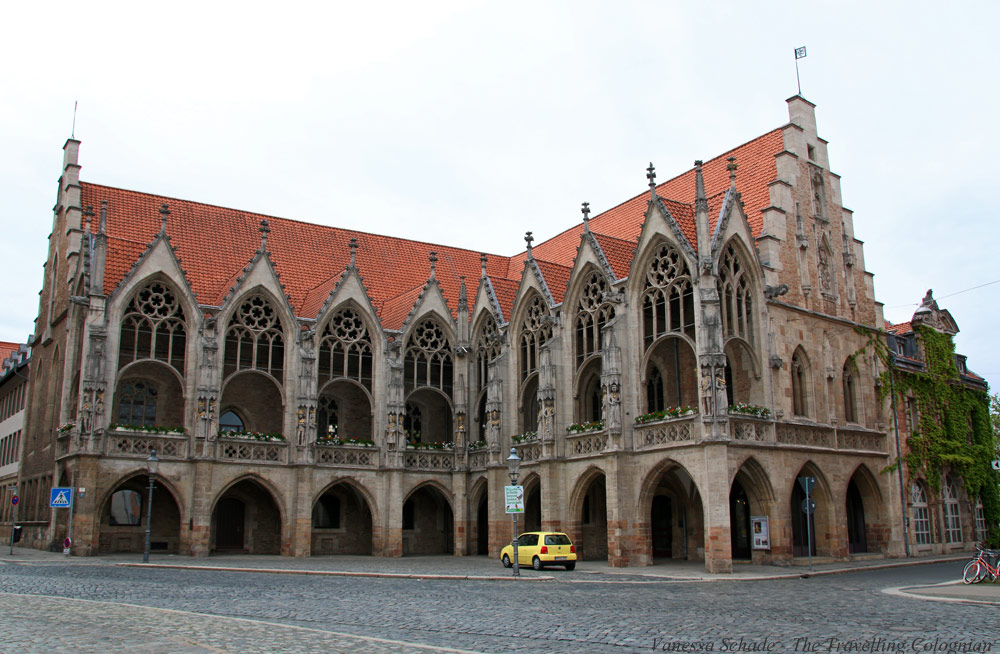 Old Town City Hall
Old Town City Hall
Wrestler Fountain (Ringerbrunnen)
On the way back from the old town market to the castle square, you will pass the Wrestler fountain (Ringerbrunnen). It is located in the middle of the pedestrian zone, where the Shoe street and the Sack street cross each other and was created in 1975 by Jürgen Weber. The bronze statue shows two competitive athletes during a wrestling match, one lifting and overpowering the other.
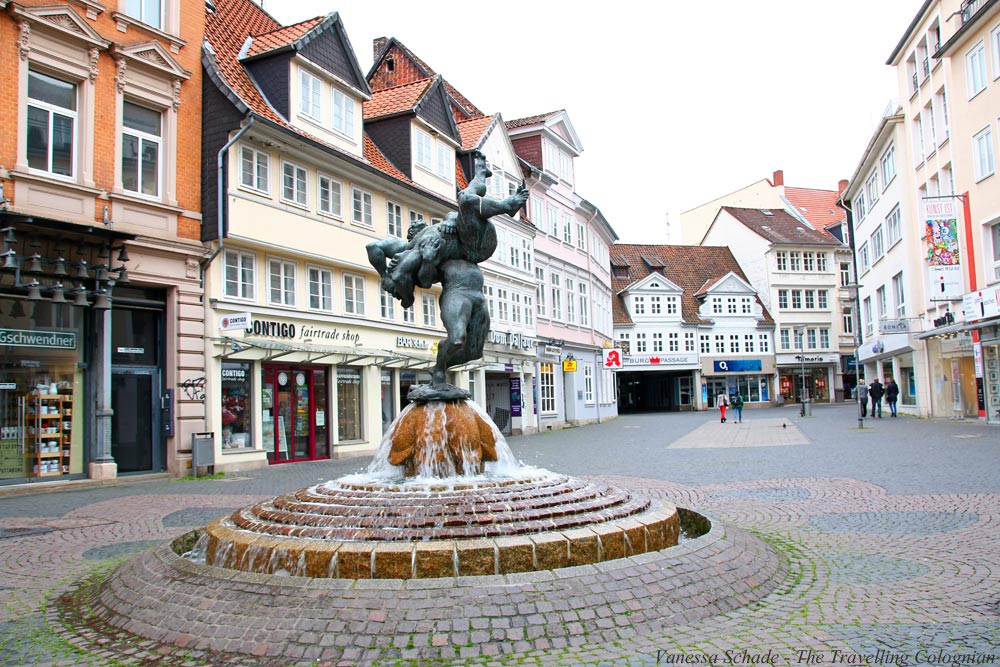 Wrestler Fountain
Wrestler Fountain
Old Scale (Alte Waage)
The Old Scale (Alte Waage), a freestanding half-timbered building, is located in the very north of Brunswick’s city centre in front of St. Andrew’s Church. The original building of the Old Scale was built in 1534 and served as a scale and storage house at that time. Since the building was no longer used from 1671 on, it decayed over time and was first restored in 1854. In February 1944, during the Second World War, the Old Scale was destroyed and demolished after the war. Only at the beginning of the 1990s, it was rebuilt using stored original parts, and completed in 1994. Since then, it has been used by the Volkshochschule.
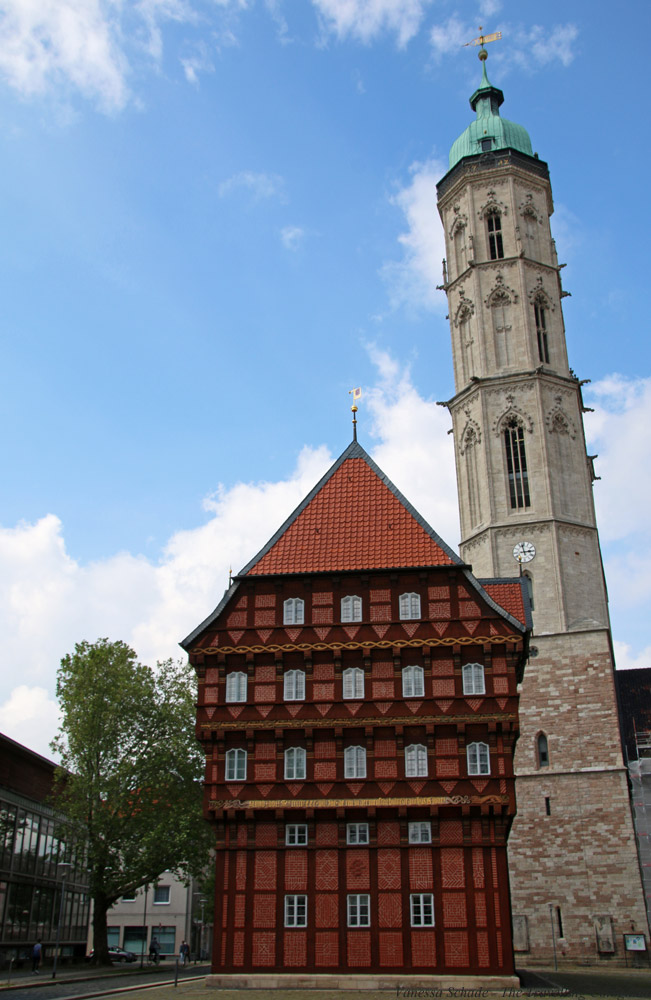 Old Scale (front) and St. Andrew’s Church (behind)
Old Scale (front) and St. Andrew’s Church (behind)
Brunswick from Above
From church or town hall towers, you get the best view of a city. If you want to enjoy a fantastic view of Brunswick from above, you should climb the Town Hall Tower, the Quadriga platform of the Brunswick Castle or the South Tower of St. Andrew’s Church.
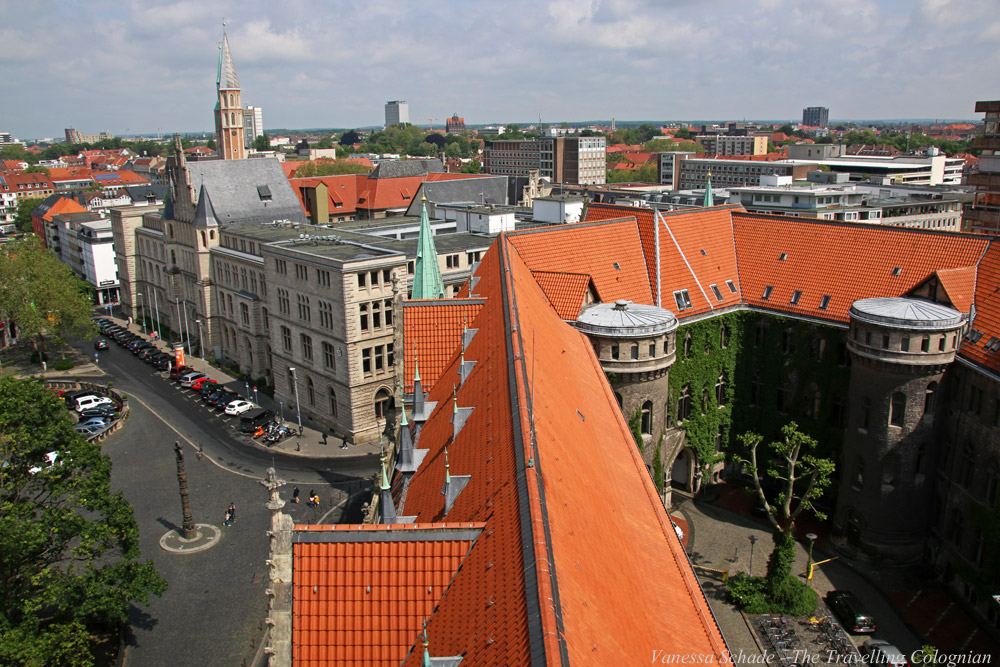 Brunswick with the Pillar 2000 Years Christianity (bottom left) from above
Brunswick with the Pillar 2000 Years Christianity (bottom left) from above
Brunswick from the Town Hall Tower
The Brunswick Town Hall Tower is 61 meters high. To get to the observation deck, you will first have to climb 161 steps, but the view from the top is worth the effort. From here you will have an excellent view over the city, but especially on the Brunswick Cathedral St. Blasii, on the Castle Square and the Brunswick Castle with the Quadriga. The ascent is possible from Monday to Friday from 9 AM to 3 PM. Admission is free, but at first, you have to register with the gatekeeper, who then opens the door to the tower.
 Brunswick Cathedral from above
Brunswick Cathedral from above
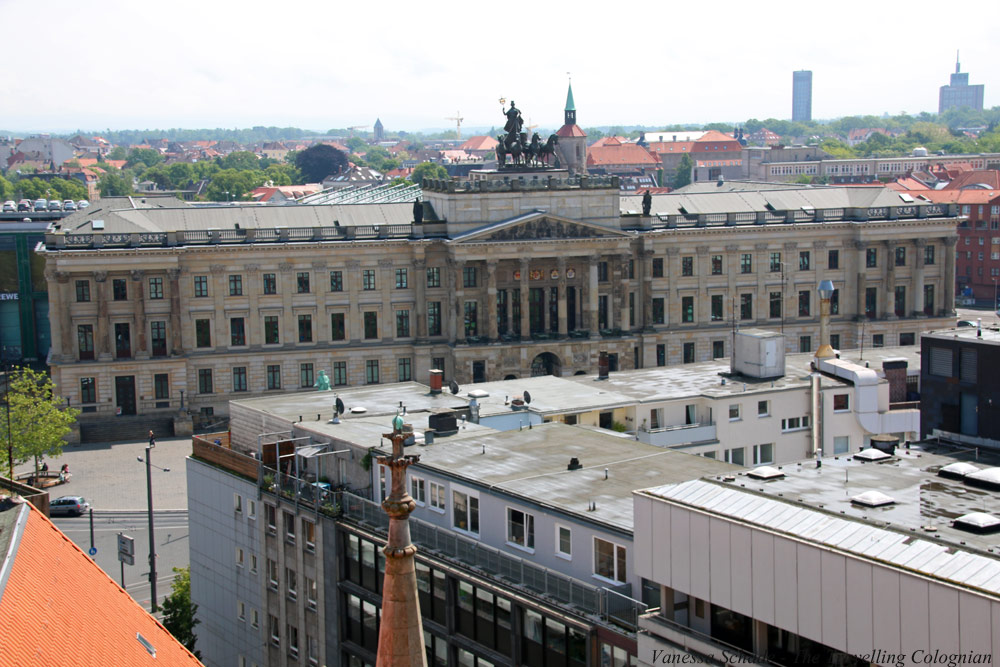 Brunswick Castle with the Quadriga from the Town Hall Tower
Brunswick Castle with the Quadriga from the Town Hall Tower
Brunswick from the Quadriga Platform
You can make the ascent to the Quadriga platform of the Brunswick Castle much less strenuous than climbing the Town Hall Tower and the South Tower of St. Andrew’s Church. Here you can choose to take the elevator or 153 steps up. Picture panels in the stairwell document the history of the Brunswick Castle up to the present day. From the Quadriga platform, you have a great view of the Castle Square, the Magni Quarter, the Town Hall Tower and the Brunswick Cathedral. You can also circle the Quadriga. The Quadriga platform is open from April to September, Monday through Sunday from 10 AM to 8 PM, and from October to March, from Mondays to Sundays from 10 AM to 4:30 PM. The ascent is possible until half an hour before closing and costs 2 euros.
 Quadriga on the Brunswick Castle
Quadriga on the Brunswick Castle
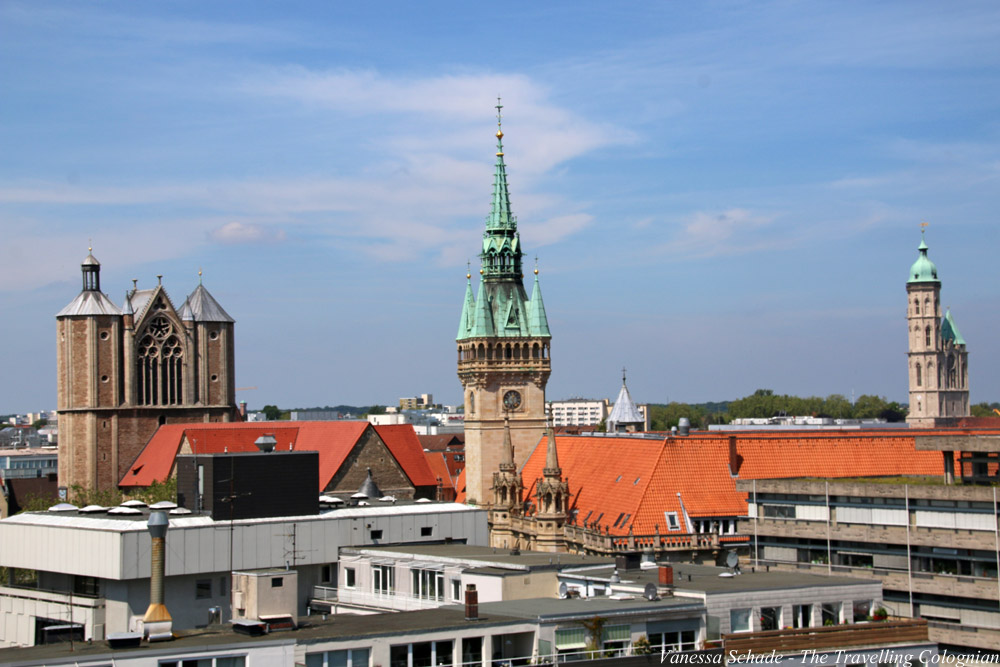 Brunswick Cathedral and Town Hall from the Quadriga
Brunswick Cathedral and Town Hall from the Quadriga
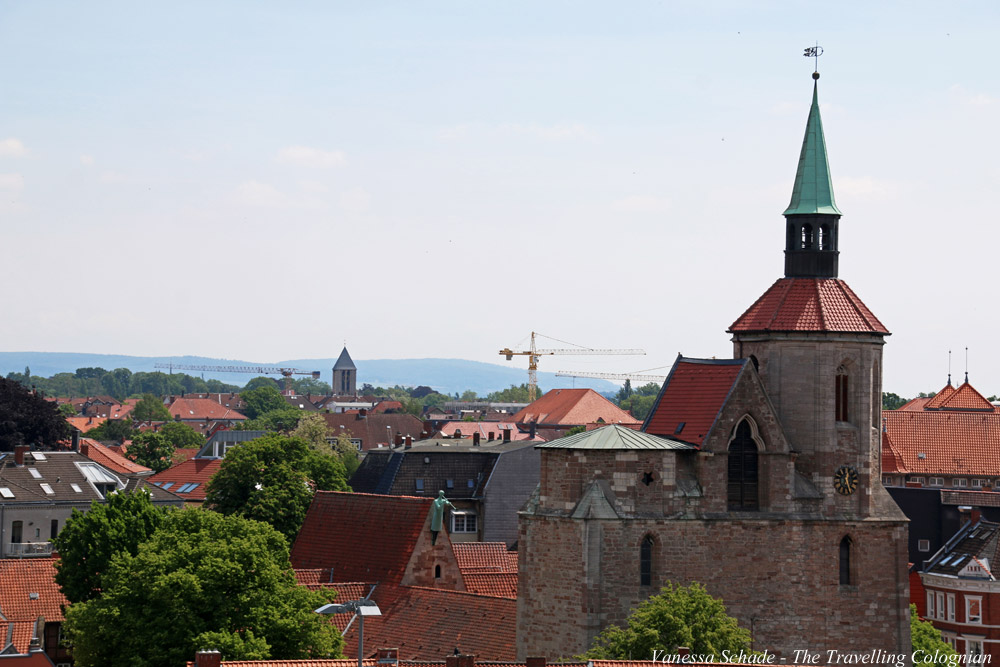 Magni Quarter from the Quadriga
Magni Quarter from the Quadriga
Brunswick from the South Tower of St. Andrew’s Church
389 steps lead to the observation deck of the South Tower of St. Andrew’s Church, which is located at an altitude of 72 meters. In the staircase, photos of historic Brunswick are exhibited. The steps are relatively wide. If you are afraid of heights you should know that you can look down during the ascent. From the viewing platform, you will have a fantastic view over Brunswick and the surrounding area, with good visibility even to the Harz mountains. What, I think, is a pity from a photographer’s perspective is that all openings are provided with fine wire mesh. This heavily affects photography with a digital SLR. But I turned my smartphone until I could take pictures without disturbing wire mesh.
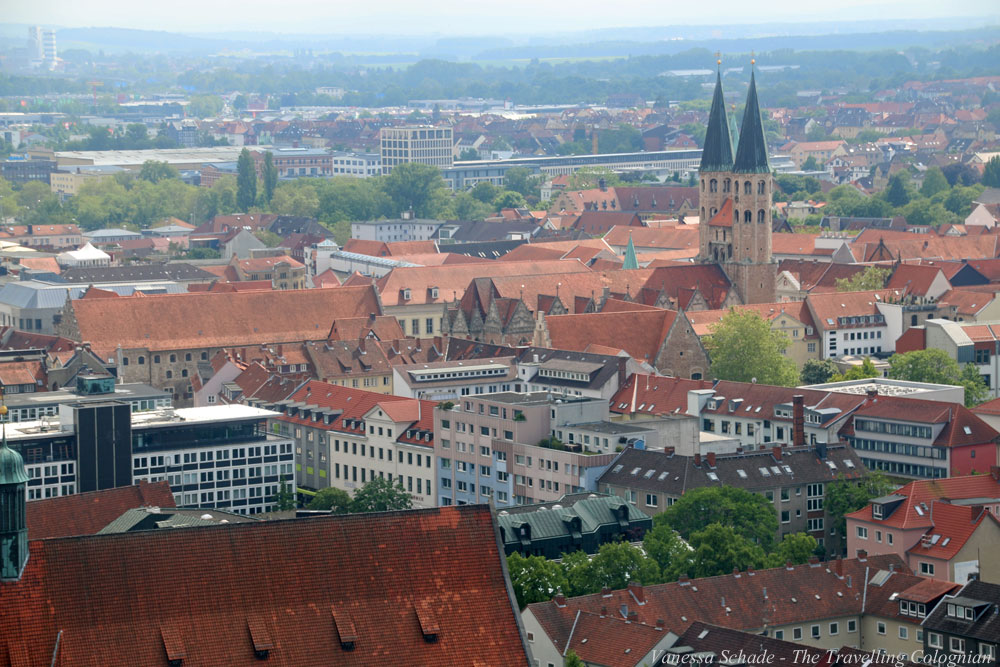 From the South Tower of St. Andrew’s Church you get the best view over Brunswick
From the South Tower of St. Andrew’s Church you get the best view over Brunswick
 Church St. Katharinen at the Hagen Market from above
Church St. Katharinen at the Hagen Market from above
The South Tower can be climbed between April 1 and October 30 on Wednesdays to Sundays from 3 to 5 PM and between November 1 and March 31 only on weekends between 3 and 5 PM. The ascent costs 2 euros for adults and 1 euro for pupils, students and the unemployed. Children under the age of 16 have free admission when being accompanied by an adult.
(Boat) Tours on the Oker
The Oker is a nearly 130-kilometer-long river, which springs in the Harz mountains and frames the inner city of Brunswick in a ring shape. The banks of the Okerumflut are lined with trees, villas and green spaces. A ride with a wooden raft promises the perfect relaxation. If you like something more active, you can rent a kayak, canoe or pedal boat.
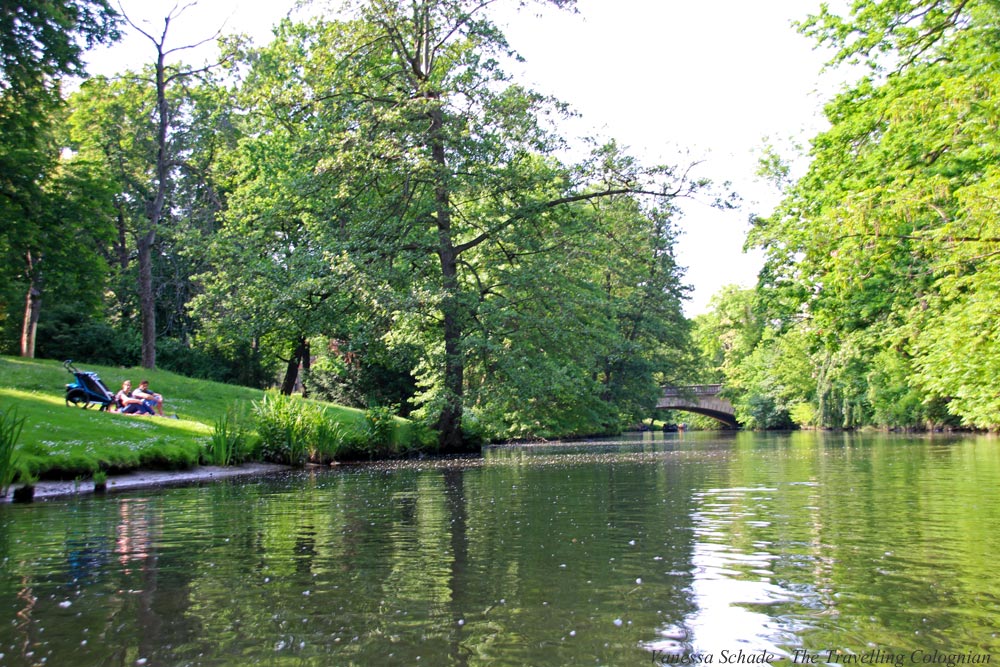 The Banks of the Oker are lined with green areas, meadows, and villas
The Banks of the Oker are lined with green areas, meadows, and villas
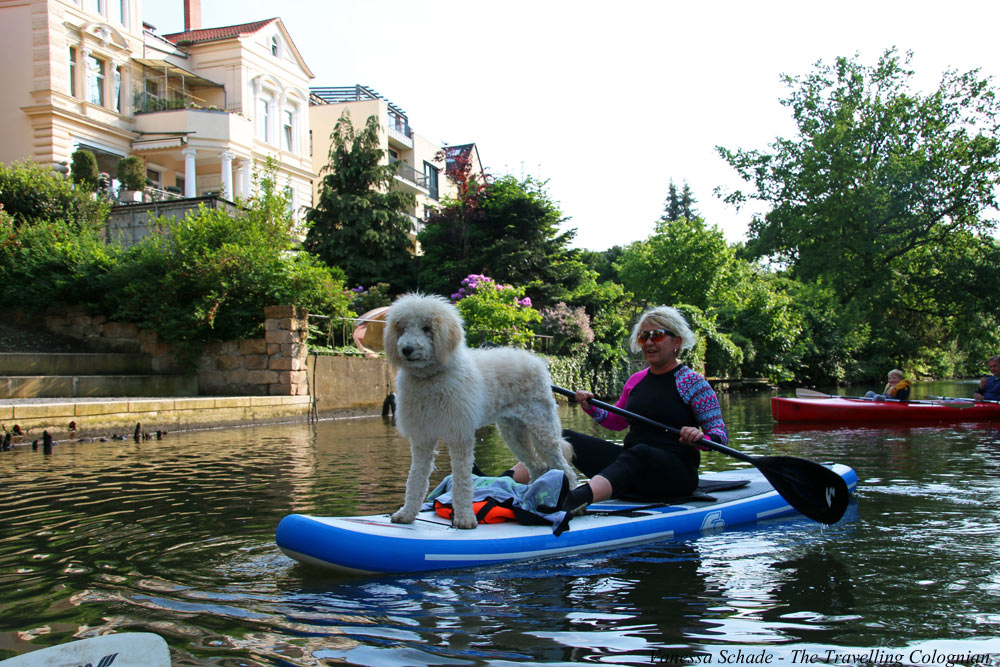 Encounters on the Oker
Encounters on the Oker
Rafting and Boat Trips on the Oker
You can ride on the Oker relaxed and slowly with a wooden raft or boat. Two fellow travel bloggers of me have done that. Boats are used up to a maximum of 30, rafts up to 50 people. Both are steered by a boat operator and are equipped with beer tables and benches so that you can eat and drink during the ride. Food and drinks may not be brought but can be ordered on the spot. The trips take one and a half, two or three hours and cost about 12 to 18 euros for adults. Children from 6 to 11 pay only half the price, children under 6 have free admission.
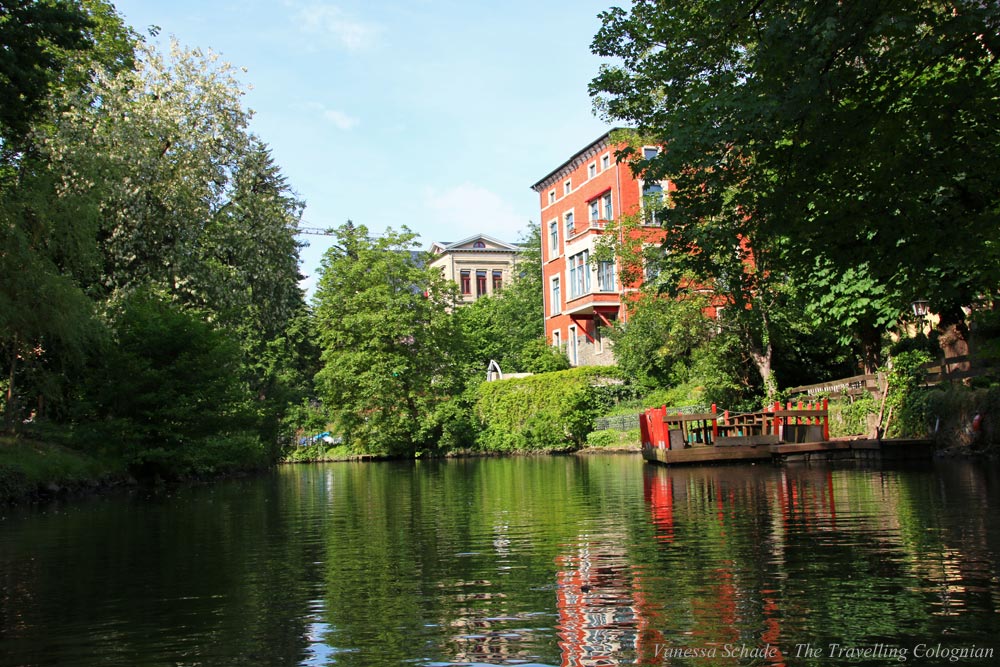 You can ride on the Oker relaxed and slowly with a wooden raft
You can ride on the Oker relaxed and slowly with a wooden raft
Kayaking and Canoeing on the Oker
You can also go kayaking or canoeing along the Oker for an hour or more while actively experiencing the landscape. I did that with some of my fellow bloggers. If you want to circle the inner city of Brunswick on the Oker by kayak or canoe, you need about three hours. Kayaks for two people cost about ten euros an hour and for three people twelve euros an hour.
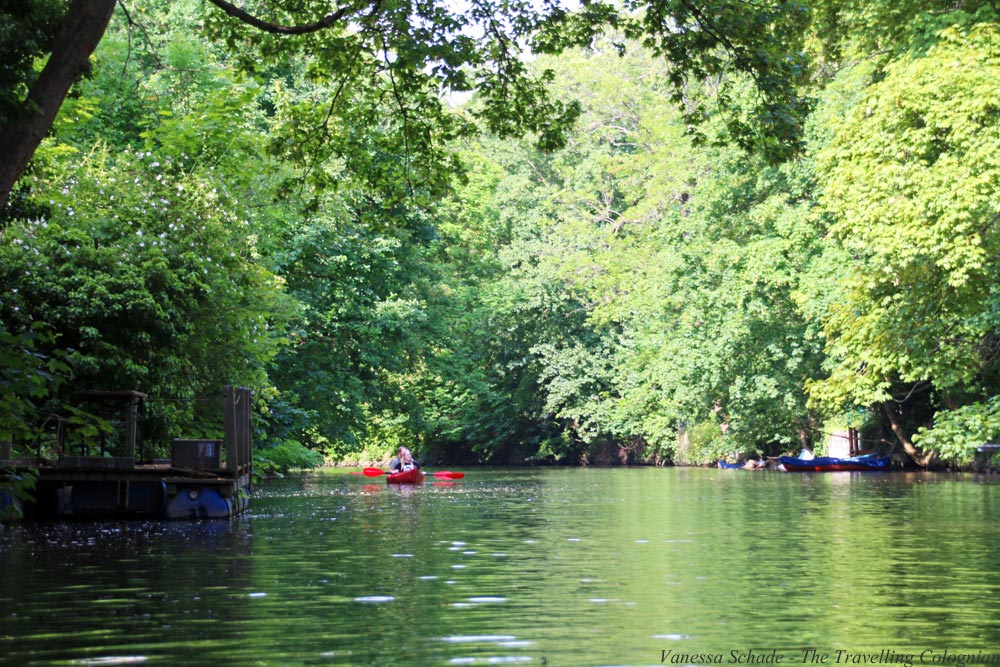 Kayaking and Canoeing on the Oker
Kayaking and Canoeing on the Oker
Pedal boating on the Oker
Even with a pedal boat, you can ride along the Oker. Pedal boats are suitable for up to four adults and one child and cost about 14 to 16 euros per hour.
Further Sights in Brunswick
- Aegidien Market (Ägidienmarkt) with the church St. Aegidien (Kirche St. Ägidien)
- Castle Museum Brunswick
- Duke Anton Ulrich Museum
- Eulenspiegel Fountain (Eulenspiegelbrunnen)
- Hagen Market with the Church St. Katharinen (Hagenmarkt mit der Kirche St. Katharinen)
- Heinrichs Fountain (Heinrichsbrunnen)
- Kemenate Hagenbrücke
- Michaelis Quarter with St. Michael ‘s Church (Michaelisviertel mit der Kirche St. Michaelis)
- Lessing Monument (Lessing-Denkmal)
- Light Parcours along the Umflutgraben, which takes place every few years – the next time in the summer of 2020
- Monastery Riddagshausen (Kloster Riddagshausen)
- Museum of Photography
- Old Customs and Landwehr House (Altes Zoll- und Landwehrhaus)
- St. Peter’s Church (Kirche St. Petri)
- State Natural History Museum
- State Theater
- Richmond Castle
- Theater Bridge
- Water Tower
- Zoo Brunswick
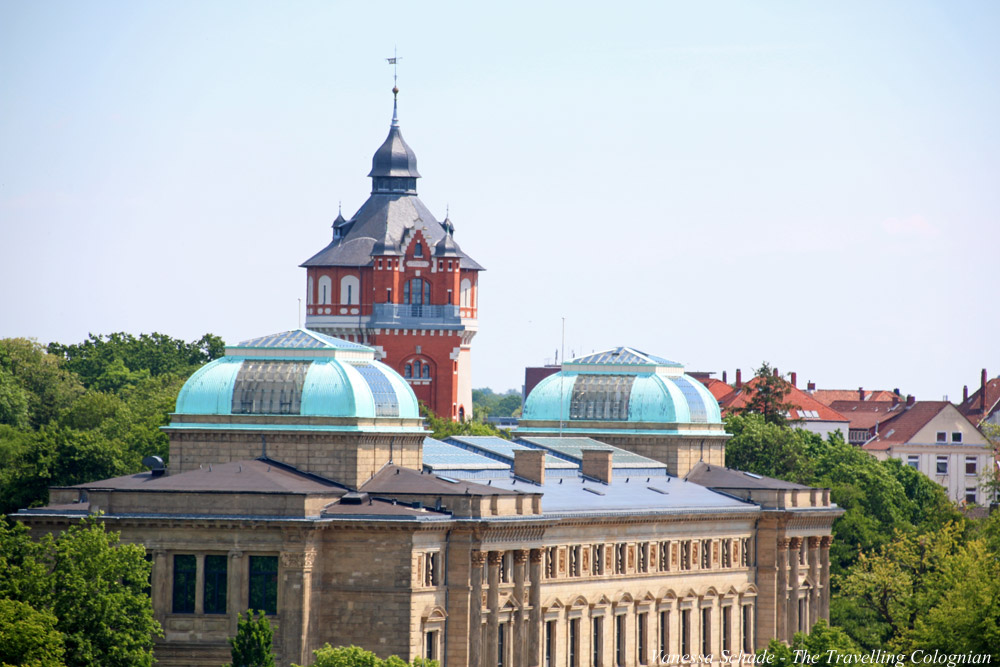 Water Tower Brunswick
Water Tower Brunswick
History and Economics
The beginning of the history of Brunswick is relatively controversial. According to legend, Brunswick was already founded in 861, but the first mention by name is evidenced by the dedication certificate of the Magni Church. The city was first mentioned in 1031 as Brunesguik, in the late Middle Ages its name was Brunswiek and in 1542 it became Brunswick.
The Guelph Henry the Lion, who was Duke of Saxony and Bavaria, took over Brunswick in 1139 and made it his residence city in the following years. He expanded Dankwarderode Castle and made it his base in Brunswick. In 1166 he set up a lion made of bronze in front of Dankwarderode Castle. He burned down the church, which stood right next to the castle, and built the Brunswick Cathedral of St. Blasii at the same point from 1173 to 1195. He also constructed the quarter around the Hagen Market. He was a warrior who travelled a lot around the world. However, he spent his last years in Brunswick, where he died in 1195, and he was buried in the Brunswick Cathedral together with his second wife Mathilde. The name Lion City – how Brunswick is also called – goes back to him.
Before the Second World War Brunswick had the largest coherent half-timbered city in Germany. However, this was destroyed to 90 percent in a bombing raid of the British in just two and a half days in October 1944. Only the five so-called traditional islands – Castle square, Magni Quarter, Aegidien, Old Town Market and Michaelis – are partially preserved or they were faithfully rebuilt.
 Until the Second World War Braunschweig had the largest coherent half-timbered city centre
Until the Second World War Braunschweig had the largest coherent half-timbered city centre
Today, Brunswick is doing very well economically. The city is the second-largest in Lower Saxony and has almost 250,000 inhabitants. Brunswick has been the seat of Volkswagen’s financial department since 1994. Besides, Nordzucker AG, Verlagsgruppe Westermann, Robert Bosch GmbH and Schimmel Pianos are based here. With Eintracht Braunschweig, the city also has a well-known football club.
Brunswick Hotels
I stayed at the Forsthaus Appartements in Brunswick together with my five fellow travel bloggers. We were accommodated in one large apartment with four bedrooms, two bathrooms, a kitchen and in two single apartments with kitchenette and private bathroom. I stayed in one of the single apartments. The accommodation is a bit farther outside, but you can take the trams M1 and M2 to Brunswick castle, the Town Hall, and the Central Train Station.
Getting there
By Train
If you travel to Brunswick by train, you can either take the regional train, the Intercity (IC) or the Intercity-Express (ICE), depending on where you come from. All trains arrive in Brunswick at the main station. It is located in the southeast of the city and is accessible by tram lines M1, M2 and M5 and by bus lines 411, 419, 420, 429, 431, 436, 461, 601, 603, 620, 631 and 730.
By Car
If you travel to Brunswick by car, you will probably get there on the highways A2 / E30, A39, A391, A392 or A395. There are 18 connection points available throughout the city. Alternatively, you can also travel via the B1 and the B4 as well as via three other federal highways.
By Long-Distance Bus
Of course you can also take a long-distance bus to Brunswick, but in this case, the journey takes considerably longer than by train or by car. All long-distance buses stop directly at the main train station in Brunswick.
Conclusion
Brunswick is worth a visit and if you are in the North of Germany for a few days, you should also plan one or two days (or more) for Brunswick. The Christmas market, which takes place every year on the Castle Square and behind Dankwarderode Castle, must be especially atmospheric. I would like to visit the Christmas market during another stay in the city and let the Christmas spirit in Brunswick affect me.
 The Castle Square is beautiful and must be particularly atmospheric during the Christmas season
The Castle Square is beautiful and must be particularly atmospheric during the Christmas season
ReisebloggerWG
I was part of the ReisebloggerWG in Brunswick. Together with my fellow travel bloggers Andrea from Indigoblau, Ilona from Wandernd, Janett from Teilzeitreisender, Sandra from Tracks and the City and A decent cup of tea and Max from Hostelmax I visited the city for two days in cooperation with the city marketing Brunswick. I also did a search engine optimization (SEO) workshop which was taught by Max.
Did you like this article? Then, I would be glad if you leave me a comment.
If you would like to accompany me on my travels, subscribe to my latest posts via my RSS-Feed or follow me on Facebook, Twitter, and Instagram.

This town looks cool Vanessa.
I love North Germany but somehow, I’ve never heard of Brunswick. I think it’s time to go there! :D